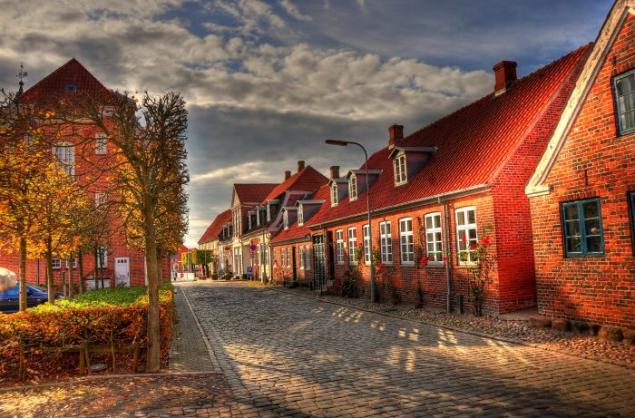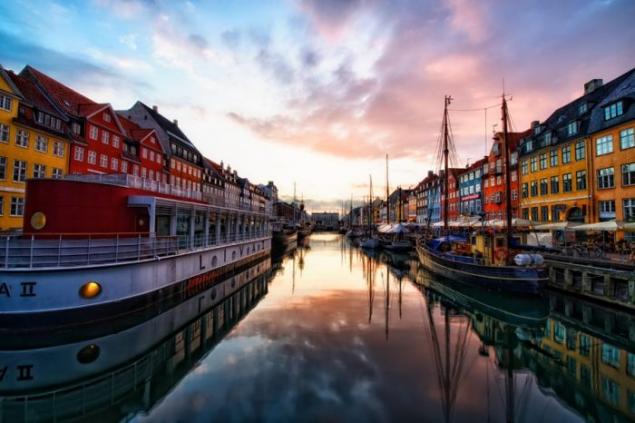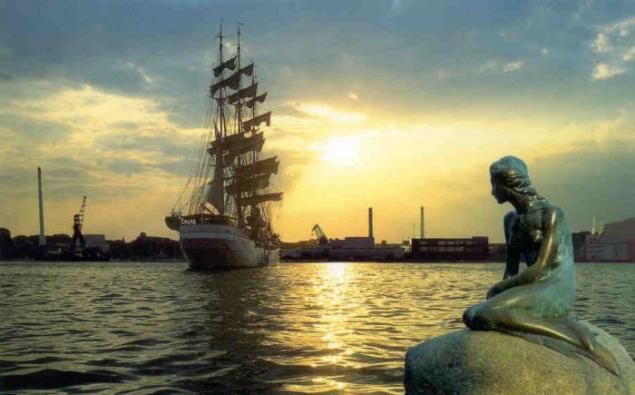Interesting facts about Denmark
 Bashny.Net
Bashny.Net
The national flag of Denmark is the oldest existing flag in the world. Its formal establishment took place in the distant 1219.
According to the annual research of the University of Cambridge, the Danish people is the happiest in Europe.

The Danish neodnorazovye was recognized as the most slender women in Europe.
In 1989 Denmark was the first in the world legalized same-sex marriage (although neither same-sex marriage was not officially signed until 2012).
Denmark is in the TOP 5 European countries with the highest levels of employment (>75%).
The average Dane is getting married at the age of 32, the average Dane is 31.
Denmark can boast of free medicine: every person has health insurance, which is paid by the state; everyone can use the services of "family doctor".
Designers for children LEGO was invented in Denmark in 1949. In a few years, they have been successfully sold worldwide. To further promote this constructor, the company's management decided to build a real amusement Park from Lego elements! At the moment there are 6 "Legoland", the largest of which is in Denmark on the Jutland Peninsula.

Few people know that the word "LEGO" is an abbreviation of the words "leg godt", which mean "play well."
Interesting fact: the territory of Denmark consists of 443 Islands, however provodniki for life are only 76 Islands.
Enthusiasts have estimated that every day citizens of Copenhagen pass by 660 thousand km on the metro and almost two times more on the bike.
In 2012, Denmark took 2nd place in nominal GDP per capita in Europe. First place went to Luxembourg. At purchasing power parity (PPP) Denmark took the 8th place in the EU.
Denmark — the birthplace of the German culture. The Franks, Burgundians, Jutes, and the Vikings originated in Denmark and also in some areas of Norway and Sweden.
Fairy tales of Hans Christian Andersen's well-known all over the world. Especially popular are such tales as "the Emperor's New clothes," "the little Mermaid" and "the Ugly duckling".

The Dane Jorn Utzon (1918-2008), architect of the iconic Sydney Opera house. In 2007, he became the second man in history, which was inscribed on the world heritage list during the life!
Denmark ranks second in the world in terms of VAT rates. Rate is within 25%. The first place on this indicator occupies Hungary.
In IX-X centuries the Danish Vikings invaded and settled in parts of Western Europe and North Africa. They settled on the land of the Danelaw in Northern England. Since then they have enjoyed the special status of their land, but under the influence of Anglo-Saxon kings.
Denmark became a member of the EU since 1973 and of NATO since 1949.
Hygge – a Danish word meaning "comfort." Nowadays it is very popular, as it is associated with winter. The younger generation often says hyggeligt.
Denmark boasts of 14 Nobel laureates (4 in literature, 5 in physiology/medicine and 1 Peace Prize).
In the period from 1397 in 1524 the whole of Scandinavia (Denmark, Sweden, Norway, Faroe Islands, Iceland and Greenland) and the southern part of Finland were United under the banner of the Danish capital, Copenhagen.
Denmark serves 12% of the global marine transportation. The country is the undisputed leader in the European region.

Most Danes speak one or two foreign languages. The most popular is English.
More than 80% of the population of Denmark included in the Danish national Evangelical Lutheran Church. Most consider themselves Protestants, but the Church did not attend.
It is interesting to know that Christmas is not a national holiday. However, the majority of Danes celebrate Christmas on 24 December.
Education in Denmark is provided free of charge at all stages. The first stage — 9 years of secondary education. Public expenditure on education and training corresponds to 7% of GDP and about 13% of total public spending.
The Danes eat more pasta than any other country in the world.
[url= lihohor.livejournal.com/680204.html#cutid1][/url]
According to the annual research of the University of Cambridge, the Danish people is the happiest in Europe.

The Danish neodnorazovye was recognized as the most slender women in Europe.
In 1989 Denmark was the first in the world legalized same-sex marriage (although neither same-sex marriage was not officially signed until 2012).
Denmark is in the TOP 5 European countries with the highest levels of employment (>75%).
The average Dane is getting married at the age of 32, the average Dane is 31.
Denmark can boast of free medicine: every person has health insurance, which is paid by the state; everyone can use the services of "family doctor".
Designers for children LEGO was invented in Denmark in 1949. In a few years, they have been successfully sold worldwide. To further promote this constructor, the company's management decided to build a real amusement Park from Lego elements! At the moment there are 6 "Legoland", the largest of which is in Denmark on the Jutland Peninsula.

Few people know that the word "LEGO" is an abbreviation of the words "leg godt", which mean "play well."
Interesting fact: the territory of Denmark consists of 443 Islands, however provodniki for life are only 76 Islands.
Enthusiasts have estimated that every day citizens of Copenhagen pass by 660 thousand km on the metro and almost two times more on the bike.
In 2012, Denmark took 2nd place in nominal GDP per capita in Europe. First place went to Luxembourg. At purchasing power parity (PPP) Denmark took the 8th place in the EU.
Denmark — the birthplace of the German culture. The Franks, Burgundians, Jutes, and the Vikings originated in Denmark and also in some areas of Norway and Sweden.
Fairy tales of Hans Christian Andersen's well-known all over the world. Especially popular are such tales as "the Emperor's New clothes," "the little Mermaid" and "the Ugly duckling".

The Dane Jorn Utzon (1918-2008), architect of the iconic Sydney Opera house. In 2007, he became the second man in history, which was inscribed on the world heritage list during the life!
Denmark ranks second in the world in terms of VAT rates. Rate is within 25%. The first place on this indicator occupies Hungary.
In IX-X centuries the Danish Vikings invaded and settled in parts of Western Europe and North Africa. They settled on the land of the Danelaw in Northern England. Since then they have enjoyed the special status of their land, but under the influence of Anglo-Saxon kings.
Denmark became a member of the EU since 1973 and of NATO since 1949.
Hygge – a Danish word meaning "comfort." Nowadays it is very popular, as it is associated with winter. The younger generation often says hyggeligt.
Denmark boasts of 14 Nobel laureates (4 in literature, 5 in physiology/medicine and 1 Peace Prize).
In the period from 1397 in 1524 the whole of Scandinavia (Denmark, Sweden, Norway, Faroe Islands, Iceland and Greenland) and the southern part of Finland were United under the banner of the Danish capital, Copenhagen.
Denmark serves 12% of the global marine transportation. The country is the undisputed leader in the European region.

Most Danes speak one or two foreign languages. The most popular is English.
More than 80% of the population of Denmark included in the Danish national Evangelical Lutheran Church. Most consider themselves Protestants, but the Church did not attend.
It is interesting to know that Christmas is not a national holiday. However, the majority of Danes celebrate Christmas on 24 December.
Education in Denmark is provided free of charge at all stages. The first stage — 9 years of secondary education. Public expenditure on education and training corresponds to 7% of GDP and about 13% of total public spending.
The Danes eat more pasta than any other country in the world.
[url= lihohor.livejournal.com/680204.html#cutid1][/url]
Tags
See also
19 psychological facts that you did not know about yourself
Psychological facts about you
Interesting stories about flags
Psychological facts about you (19 pictures)
Myths and facts about marriage
10 interesting facts about psychology
Facts you never knew about yourself
18 syndromes, which you did not know
100 facts about Saudi Arabia
Alexander Nevski

















